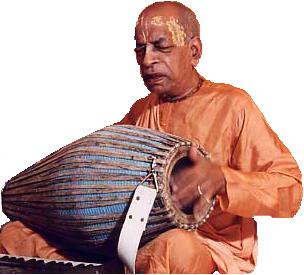Krsna Kirtana Songs est. 2001 www.kksongs.org
Home ⇒ Music Center ⇒ Instrumental Guides ⇒ Khol Guide
Lesson 10: Prabhupāda/Dasapahirā Tālas
The rhythmic cycles taught in lesson 9 were eight beats in length. For the most part, the kahervā rhythms are used in bhajans and kirtans.
The rhythmic cycle of this lesson is another very common and very important rhythm in bhajans and kirtans. It is known in ISKCON as Prabhupāda tāla. Prabhupāda tāla was named after Gour Mohan De, Śrīlā Prabhupāda’s father, who taught this rhythmic cycle to him. It’s also known as dasapahirā tāla amongst the Bengali tradition.

Here is Śrīlā Prabhupāda playing the mridanga. Jaya Śrīlā Prabhupāda!
This tāla has sixteen mātrās per cycle.* The cycle, including the theka, is prone to many variations.
The thekā is as follows:
|
X |
|
|
|
|
|
|
|
0 |
|
|
|
2 |
|
|
|
||||
|
1 |
2 |
3 |
4 |
5 |
6 |
7 |
8 |
9 |
10 |
11 |
12 |
13 |
14 |
15 |
16 |
||||
|
dha |
|
ti |
tā |
tā |
ra |
ti |
ra |
ti |
tā |
ki |
ti |
ki |
tā |
ghe |
dhā |
dhin |
dhā |
dhin |
dhā |
This is divided 8+4+4, with the tālī on the sam and mātrā 2, while the khali is on mātrā 9.
Now, at the first look, this rhythmic cycle looks a very difficult compared to the relatively simple kahervā tāla and its prakārs. The best way to approach this rhythmic cycle is to study it based on each set of four mātrās.
PART ONE: dhā PAUSE ti tā
To help you keep time, make sure you actually say the word PAUSE. We had a couple of prakārs in kahervā tāla where there were spaces. Likewise, the first two beats is occupied by the bol “dhā.”
PART TWO: tā rati rati tā
The bol “ti ra” occupies one beat.
PART THREE: ki tiki tāghe dhā
Just like in PART TWO, the bols “tiki” and “tāghe” has the duration of one mātrā each. Remember that baya bols have vowel tolerance, so “ki” and “ghe” are the same as “ka” and “gha” that we studied in Lesson 3.
PART FOUR: dhā dhin dhā dhin
PRABHUPĀDA TĀLA CYCLE:
To give you an idea of how this fits with kartals, please listen to the following clip.
ACCOMPANIMENT PRACTICE:
The only way to get better with this rhythmic cycle is only through practice. Just like with Kahervā tāla, Prabhupāda tāla is a frequently used rhythmic cycle, as many kīrtanas begin with this rhythm. Again, we will use the mahamantra as our practice template. For this specific tune, the first mātrā falls on the first syllable of the first “Krsna” in the mahamantra.
Here is another example exercise. The following recording is a kirtana with the morning tune in Raga Bangala. You can either sing the Gurvastakam or the standard pranati prayers (Prabhupada pranama, Panca Tattva mahamantra, and Hare Krishna mahamantra).
VIDEOS:
·VIDEO CLIP 10 – 1: Prabhupāda Tāla Theka: DIDACTIC
· VIDEO CLIP 10 – 2: Prabhupāda Tāla Theka: PRACTICE
After putting the pieces together, this rhythmic cycle is a very common one. It is usually found at the start of kirtans as well as slow tempo bhajans. Therefore, make sure this rhythmic cycle is mastered before moving onto the prakārs or any other cycle.
*EDITOR’S NOTE: For many reasons due to tāla structure, it can be argued that Prabhupāda/Dasapahirā tāla is an eight beat cycle. I have taught this in the past and I realized that this became a source of confusion when we discussed accompaniment, due to layakari differences. Hence, this is presented as a sixteen beat cycle.
UPDATED: October 14, 2017
